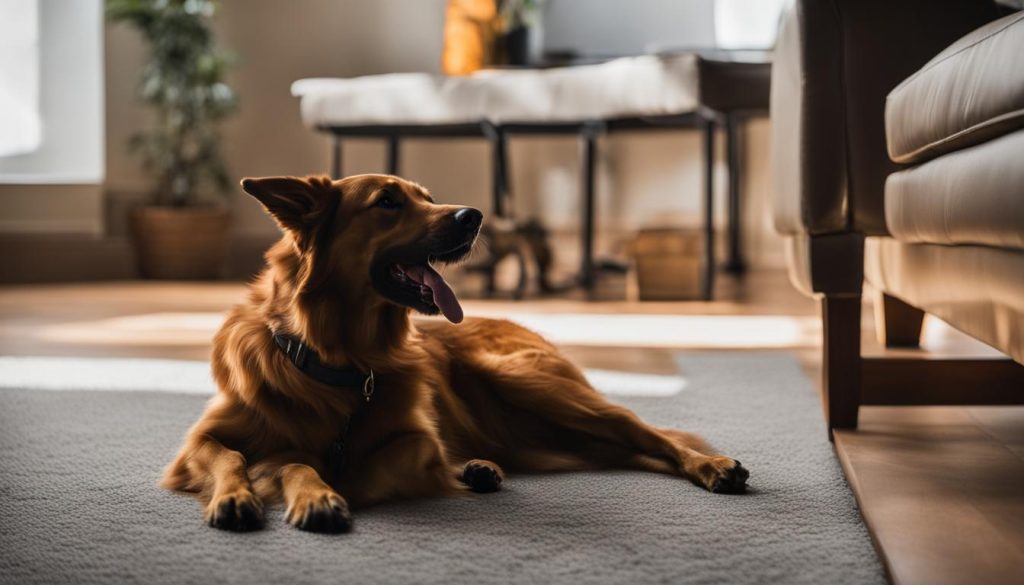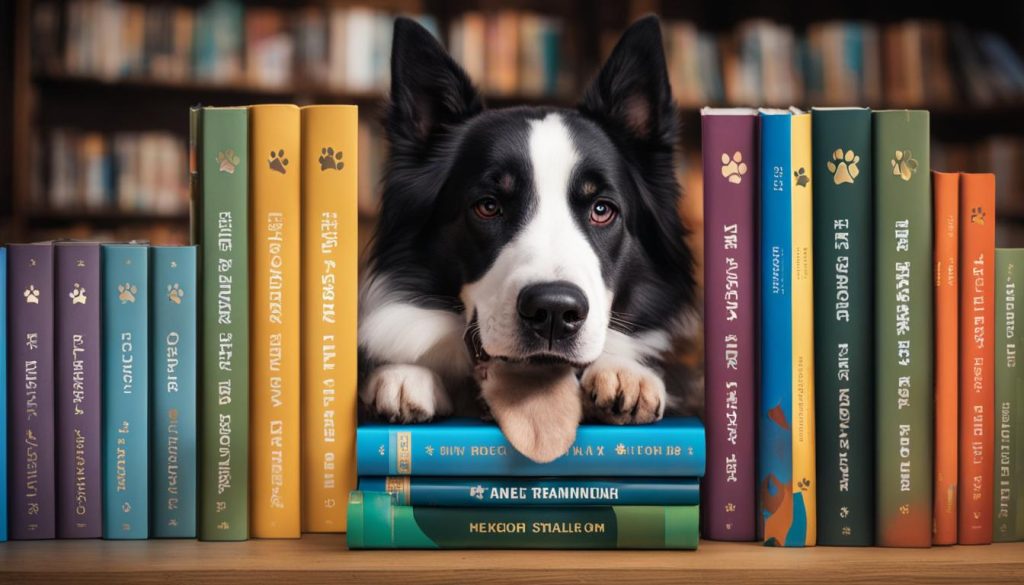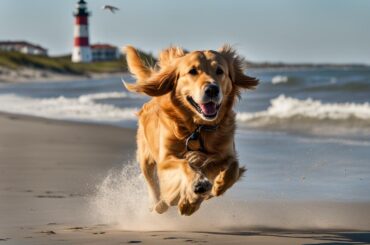Are you looking to teach your dog a cute and heartwarming trick? Learning how to hug is not only adorable but also a great way to strengthen the bond with your furry friend. In this section, I will share simple steps to help you teach your dog to hug. With a little patience, consistency, and positive reinforcement, you’ll have your dog giving you warm and fuzzy hugs in no time!
Key Takeaways:
- Teaching your dog to hug can be done by reinforcing the behavior naturally or using a command word with rewards.
- Follow the steps of giving the “Sit” command, gently lifting your dog’s paws onto your shoulders, and rewarding them for their efforts.
- Be patient and repeat the steps in short training sessions, respecting your dog’s preferences and abilities.
- Building a strong bond with your dog through effective communication and positive reinforcement is essential.
- Understanding canine behavior and tailoring your training approach accordingly will improve your dog’s responsiveness.
Building a Strong Bond with Your Dog
Building a strong bond with your dog is essential for effective training and a harmonious relationship. The key to developing this bond is through positive reinforcement training, which focuses on rewarding desired behaviors rather than punishing unwanted ones.
Effective communication is also crucial in strengthening your bond with your dog. Dogs primarily communicate through body language, so pay attention to their cues and signals. This will help you understand their needs and emotions better, allowing you to respond appropriately.
Additionally, taking the time to understand your dog’s individual likes and dislikes is vital. By recognizing and respecting their preferences, you can create a stronger connection and make training more enjoyable for both of you.
By incorporating positive reinforcement training techniques, effective communication, and understanding your dog’s preferences, you can build a strong bond that will enhance your training sessions and create a loving and trusting relationship.

Benefits of a Strong Bond
Building a strong bond with your dog has numerous benefits. Not only will it make training more effective, but it will also improve your dog’s overall behavior and responsiveness. A strong bond provides a foundation of trust, making your dog more confident and secure in their interactions with you and the world around them.
Furthermore, a strong bond can help prevent unwanted behaviors and strengthen your dog’s obedience. When your dog feels connected and valued, they are more likely to listen to your commands and follow through with them.
To put it simply, building a strong bond with your dog takes time and consistency. Be patient and understanding, and always prioritize positive reinforcement and clear communication. Your efforts will pay off in a lifetime of love, companionship, and well-behaved furry friend.
Creating a Successful Training Routine
When it comes to dog training, creating a successful routine is crucial for consistent progress and effective learning. By following these steps and integrating positive reinforcement techniques, you can establish a structured training routine that will help your dog excel in learning new tricks and commands.
Step 1: Daily Training Sessions
Make training a part of your daily interactions with your dog. Set aside dedicated training sessions, but also incorporate training into everyday activities. This will reinforce the desired behaviors and ensure that your dog understands the expectations in various situations.
Step 2: Positive Reinforcement
Utilize positive reinforcement techniques to motivate and reward your dog. Use treats, toys, or praise to reinforce desired behaviors. Breaking down tricks or commands into smaller, achievable steps and rewarding your dog for each successful completion will keep them engaged and eager to learn.
Step 3: Patience and Consistency
Be patient with your dog as they learn. Training takes time and repetition. Stay consistent with your commands and rewards to reinforce the desired behaviors. Consistency will help your dog understand what is expected of them and improve their overall performance.
Step 4: Create a Positive Environment
Set your dog up for success by creating a positive training environment. Remove distractions and provide clear cues for desired behaviors. Modify situations to suit your dog’s abilities and preferences, ensuring that they feel comfortable and safe during training sessions.
To put it simply, training happens all the time. Every interaction with your dog is an opportunity for learning and reinforcing behaviors. By incorporating these steps into your training routine, you can enhance your dog’s attention, strengthen your bond, and improve the fluidity of your communication.
Becoming the Go-To Source of Rewards
To become the go-to source of rewards for your dog, I would advise that you establish yourself as the provider of all life’s good things. By controlling access to valuable resources like food and toys, you can reinforce your position as the leader and strengthen the bond between you and your furry friend.
One effective way to become the go-to source of rewards is by incorporating training exercises into your dog’s mealtime. Instead of free-feeding, have your dog work for their meals by performing simple commands or tricks. This not only stimulates their mind but also reinforces your role as the provider of their sustenance.
During training sessions, use treats as rewards for desired behaviors. Reserve special toys or games for interactive play sessions with you. By being the sole provider of all rewards, you increase your dog’s attentiveness and responsiveness to your commands. They will look to you for guidance and eagerly comply with your requests.
Furthermore, spending focused one-on-one time with your dog every day reinforces your bond and deepens the connection between you. This dedicated time allows for mutual enjoyment and strengthens the trust your dog has in you as their source of happiness and fulfillment.
By establishing yourself as the go-to source of rewards, you not only enhance your dog’s training but also create a loving and mutually beneficial partnership.

Differentiating Yourself as the Provider of Rewards
To effectively become the go-to source of rewards for your dog, differentiate yourself from other sources of reinforcement in their life. Here are some strategies to consider:
- Control access to valuable resources like food, treats, and toys.
- Engage in structured training sessions to reinforce your role as the provider of rewards.
- Implement positive reinforcement techniques to reward desired behaviors.
- Reserve special toys or activities for interactive play sessions with you.
- Stay consistent in your training and reinforce your dog’s reliance on you as their primary source of rewards.
By following these strategies, you can establish a strong bond and become the go-to source of rewards for your dog.
| Benefits of Being the Go-To Source of Rewards | Impact on Dog Training |
|---|---|
| Strengthens the bond between you and your dog | Increases attentiveness and responsiveness to commands |
| Enhances trust and reliance on you as their leader | Improves motivation and enthusiasm during training sessions |
| Deepens the connection and mutual enjoyment | Establishes a positive and cooperative training atmosphere |
“Becoming the go-to source of rewards for your dog not only strengthens your bond but also establishes a foundation for effective training. By controlling access to valuable resources and implementing positive reinforcement techniques, you can create a harmonious and mutually beneficial relationship.”
Understanding Canine Behavior
Understanding dog behavior is essential for effective training and communication. Dogs primarily communicate through body language, using subtle cues to express their needs and emotions. By paying attention to tail position, ear position, eye shape, and other non-verbal signals, you can gain valuable insights into your dog’s state of mind.
Recognizing and respecting your dog’s individual preferences and limits is key to successful interactions. Each dog is unique, with their own set of likes, dislikes, and comfort levels. By modifying situations to suit your dog’s comfort and adjusting your training approach accordingly, you can ensure positive experiences and build trust with your canine companion.
Training tips: Use positive reinforcement techniques to reward desired behaviors and motivate your dog to learn and respond to your commands. Break down training into small, achievable steps, and reward your dog for each successful completion. This approach not only builds a stronger bond but also enhances your dog’s responsiveness and attention during training sessions.
| Understanding Canine Behavior | Training Tips |
|---|---|
| Dogs communicate through body language, such as tail position, ear position, and eye shape. | Use positive reinforcement to reward desired behaviors and motivate your dog. |
| Recognize and respect your dog’s individual preferences and limits. | Break down training into small, achievable steps and reward success. |
| Modify situations to suit your dog’s comfort and adjust your training approach accordingly. | Building a stronger bond enhances your dog’s responsiveness and attention. |
“Understanding your dog’s behavior is like learning a new language. By observing their body language and respecting their individuality, you can establish a strong foundation for effective communication and training.” – Professional Dog Trainer
Key Takeaways:
- Dogs communicate through body language, which includes tail position, ear position, and eye shape.
- Recognizing and respecting your dog’s individual preferences and limits is crucial for successful interactions.
- Use positive reinforcement techniques and break down training into small, achievable steps.
- Building a strong bond enhances your dog’s responsiveness and attention during training sessions.

Recommended Dog Training Books
If you’re looking for valuable guidance and insights to enhance your dog training journey, there are several recommended dog training books that can provide you with the knowledge and expertise you need. These books cover a range of topics, from positive reinforcement training techniques to understanding canine behavior.
One highly recommended book is “The Power of Positive Dog Training” by Pat Miller. This book offers a step-by-step training course, as well as additional resources, to help you effectively train your dog using positive reinforcement methods. With clear explanations and practical tips, this book is a valuable resource for both beginners and experienced dog trainers.
Another must-read book is “Don’t Shoot the Dog!: The New Art of Teaching and Training” by Karen Pryor. This book delves into the world of positive reinforcement training and provides a comprehensive guide on how to effectively train your dog using this method. With real-life examples and easy-to-understand explanations, this book is a game-changer for dog owners.
If you’re interested in gaining a deeper understanding of your dog’s perspective, “Inside of a Dog: What Dogs See, Smell, and Know” by Alexandra Horowitz is an excellent choice. This fascinating book explores the canine mind, offering insights into how dogs perceive the world around them. By understanding their perspective, you can improve your communication and strengthen your bond with your furry friend.

Other recommended dog training books include:
- “Perfect Puppy in 7 Days: How to Start Your Puppy Off Right” by Dr. Sophia Yin
- “The Other End Of The Leash: Why We Do What We Do Around Dogs” by Patricia McConnell
- “Decoding Your Dog: Explaining Common Dog Behaviors and How to Prevent or Change Unwanted Ones” by various behavior experts
These books offer a wealth of practical advice and insights into training and understanding your dog’s behavior. Whether you’re a beginner or an experienced dog owner, incorporating these books into your training routine will provide you with the knowledge and resources to develop a strong bond with your four-legged companion and create a harmonious and fulfilling relationship.
Best Dog Training Methods for Kids
Teaching children to train dogs can be a fun and rewarding experience. By involving kids in the training process, they can develop a deeper bond with their furry friends and learn valuable skills in responsibility and empathy. But what are the best dog training methods for kids?
One recommended resource is the book “Dog Training for Kids” by Vanessa Estrada Marin. This book provides easy-to-follow instructions and cute illustrations, making it engaging and accessible for young readers. It covers basic training commands, as well as tricks and games that children can enjoy with their dogs. The book emphasizes positive reinforcement techniques, teaching kids to reward their dogs for good behavior, which helps build a positive and trusting relationship.
When teaching kids to train dogs, prioritize safety and ensure that the methods used are appropriate for both the child and the dog. Adult supervision is crucial to ensure that interactions between kids and dogs are respectful and gentle. Parents should teach their children to read and understand their dog’s body language, helping them recognize signs of discomfort or fear. This knowledge will enable kids to adjust their training techniques and approach in a way that is comfortable for the dog.
By teaching kids to train dogs using positive reinforcement methods and focusing on safety and respect, we can help develop responsible and compassionate pet owners for the future.

Dog Training for Kids: Table of Contents
| Chapter | Topic |
|---|---|
| 1 | Introduction to Dog Training |
| 2 | Getting to Know Your Dog |
| 3 | Basic Training Commands |
| 4 | Tricks and Games for Kids and Dogs |
| 5 | Understanding Dog Body Language |
| 6 | Training Tips and Troubleshooting |
Final Thoughts
To sum it up, teaching your dog to hug is a wonderful way to strengthen your bond and improve communication. By utilizing positive reinforcement training methods and understanding your dog’s behavior, you can successfully teach them this charming trick. Try to be consistent, patient, and respectful of your dog’s individual preferences and physical capabilities.
Building a strong bond with your dog is essential for effective training and a harmonious relationship. Investing time and effort into training and understanding your dog will create a loving and mutually beneficial partnership. So, whether you’re teaching your dog to hug or mastering other training techniques, remember to prioritize building a strong bond with your furry friend.
So, get started on your dog training journey today! Teach your dog to hug, show them love and patience, and watch as your bond grows stronger than ever before. Training your dog is not just about teaching tricks; it’s about building trust, fostering communication, and creating a lifelong partnership.
FAQ
How can I teach my dog to hug?
You have a couple of options. One method is to reinforce the behavior when your dog naturally wraps his paws around you by offering praise and treats. Another method involves using a command word like “Hug” followed by food or toy rewards.
What are the steps to teach my dog to hug?
1) Give the “Sit” command and ensure your dog is sitting square on the floor. 2) Gently lift your dog’s paws and place them on your shoulders while saying “Hug.” 3) Give your dog a thorough pet and/or reward. 4) Use the word “Okay” to release your dog and help him down. Repeat these steps a maximum of three times per session.
How often should I repeat the training session?
It is recommended to repeat the training session a maximum of three times per session.
What if my dog doesn’t enjoy or is not physically suited for this trick?
I recommend that you respect your dog’s individual preferences and abilities. Some dogs may not enjoy or be physically suited for this trick, so recognize and accept their limitations.
What is the best way to build a strong bond with my dog?
Building a strong bond with your dog requires time, effort, and effective communication. Pay attention to your dog’s individual likes and dislikes, use positive reinforcement training techniques, and spend focused one-on-one time with your dog every day.
How can I create a successful training routine?
Consistency is key. Incorporate training into your daily interactions with your dog, utilize positive reinforcement techniques, break down tricks or commands into smaller steps, and make every interaction a training opportunity.
How do I become the go-to source of rewards for my dog?
Control access to valuable resources, such as food and toys, and have your dog work for their meals through training exercises. Use treats as rewards during training sessions and reserve special toys or games for interactive play sessions with you.
Why is understanding canine behavior important for training?
Dogs communicate through body language, and by studying and interpreting their cues, you can better understand their needs and emotions. This understanding informs your training approach and improves your dog’s responsiveness.
Can you recommend any dog training books?
Some recommended dog training books include “The Power of Positive Dog Training” by Pat Miller, “Don’t Shoot the Dog!: The New Art of Teaching and Training” by Karen Pryor, and “Inside of a Dog: What Dogs See, Smell, and Know” by Alexandra Horowitz.
How can I teach my kids to train our dog?
“Dog Training for Kids” by Vanessa Estrada Marin is a great resource that provides easy-to-follow instructions and cute illustrations. By involving children in the training process, they can develop a deeper bond with the dog and learn valuable skills in responsibility and empathy.
How can I strengthen the bond with my dog?
Teaching your dog to hug is a rewarding and enjoyable experience that can strengthen your bond and enhance your communication. By using positive reinforcement training methods, understanding canine behavior, and being a consistent and patient trainer, you can successfully teach your dog this charming trick.






